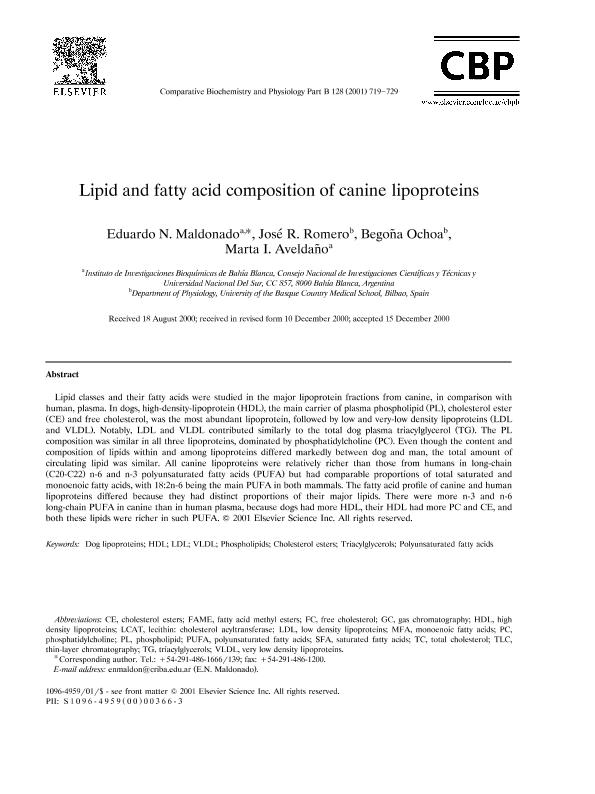Mostrar el registro sencillo del ítem
dc.contributor.author
Maldonando, Eduardo N.
dc.contributor.author
Romero, José R.
dc.contributor.author
Ochoa, Begoa
dc.contributor.author
Aveldaño, Marta Isabel

dc.date.available
2019-05-17T20:12:38Z
dc.date.issued
2001-04
dc.identifier.citation
Maldonando, Eduardo N.; Romero, José R.; Ochoa, Begoa; Aveldaño, Marta Isabel; Lipid and fatty acid composition of canine lipoproteins; Elsevier Science Inc; Comparative Biochemistry And Physiology. Part B, Biochemistry & Molecular Biology.; 128; 4; 4-2001; 719-729
dc.identifier.issn
1096-4959
dc.identifier.uri
http://hdl.handle.net/11336/76668
dc.description.abstract
Lipid classes and their fatty acids were studied in the major lipoprotein fractions from canine, in comparison with human, plasma. In dogs, high-density-lipoprotein (HDL), the main carrier of plasma phospholipid (PL), cholesterol ester (CE) and free cholesterol, was the most abundant lipoprotein, followed by low and very-low density lipoproteins (LDL and VLDL). Notably, LDL and VLDL contributed similarly to the total dog plasma triacylglycerol (TG). The PL composition was similar in all three lipoproteins, dominated by phosphatidylcholine (PC). Even though the content and composition of lipids within and among lipoproteins differed markedly between dog and man, the total amount of circulating lipid was similar. All canine lipoproteins were relatively richer than those from humans in long-chain (C20-C22) n-6 and n-3 polyunsaturated fatty acids (PUFA) but had comparable proportions of total saturated and monoenoic fatty acids, with 18:2n-6 being the main PUFA in both mammals. The fatty acid profile of canine and human lipoproteins differed because they had distinct proportions of their major lipids. There were more n-3 and n-6 long-chain PUFA in canine than in human plasma, because dogs had more HDL, their HDL had more PC and CE, and both these lipids were richer in such PUFA.
dc.format
application/pdf
dc.language.iso
eng
dc.publisher
Elsevier Science Inc

dc.rights
info:eu-repo/semantics/openAccess
dc.rights.uri
https://creativecommons.org/licenses/by-nc-sa/2.5/ar/
dc.subject
Cholesterol Esters
dc.subject
Dog Lipoproteins
dc.subject
Hdl
dc.subject
Ldl
dc.subject
Phospholipids
dc.subject
Polyunsaturated Fatty Acids
dc.subject
Triacylglycerols
dc.subject
Vldl
dc.subject.classification
Otras Ciencias Biológicas

dc.subject.classification
Ciencias Biológicas

dc.subject.classification
CIENCIAS NATURALES Y EXACTAS

dc.title
Lipid and fatty acid composition of canine lipoproteins
dc.type
info:eu-repo/semantics/article
dc.type
info:ar-repo/semantics/artículo
dc.type
info:eu-repo/semantics/publishedVersion
dc.date.updated
2019-05-14T21:34:15Z
dc.journal.volume
128
dc.journal.number
4
dc.journal.pagination
719-729
dc.journal.pais
Estados Unidos

dc.description.fil
Fil: Maldonando, Eduardo N.. Consejo Nacional de Investigaciones Científicas y Técnicas. Centro Científico Tecnológico Conicet - Bahía Blanca. Instituto de Investigaciones Bioquímicas de Bahía Blanca. Universidad Nacional del Sur. Instituto de Investigaciones Bioquímicas de Bahía Blanca; Argentina
dc.description.fil
Fil: Romero, José R.. Universidad del País Vasco; España
dc.description.fil
Fil: Ochoa, Begoa. Universidad del País Vasco; España
dc.description.fil
Fil: Aveldaño, Marta Isabel. Consejo Nacional de Investigaciones Científicas y Técnicas. Centro Científico Tecnológico Conicet - Bahía Blanca. Instituto de Investigaciones Bioquímicas de Bahía Blanca. Universidad Nacional del Sur. Instituto de Investigaciones Bioquímicas de Bahía Blanca; Argentina
dc.journal.title
Comparative Biochemistry And Physiology. Part B, Biochemistry & Molecular Biology.

dc.relation.alternativeid
info:eu-repo/semantics/altIdentifier/url/https://www.sciencedirect.com/science/article/pii/S1096495900003663
dc.relation.alternativeid
info:eu-repo/semantics/altIdentifier/doi/http://dx.doi.org/10.1016/S1096-4959(00)00366-3
Archivos asociados
